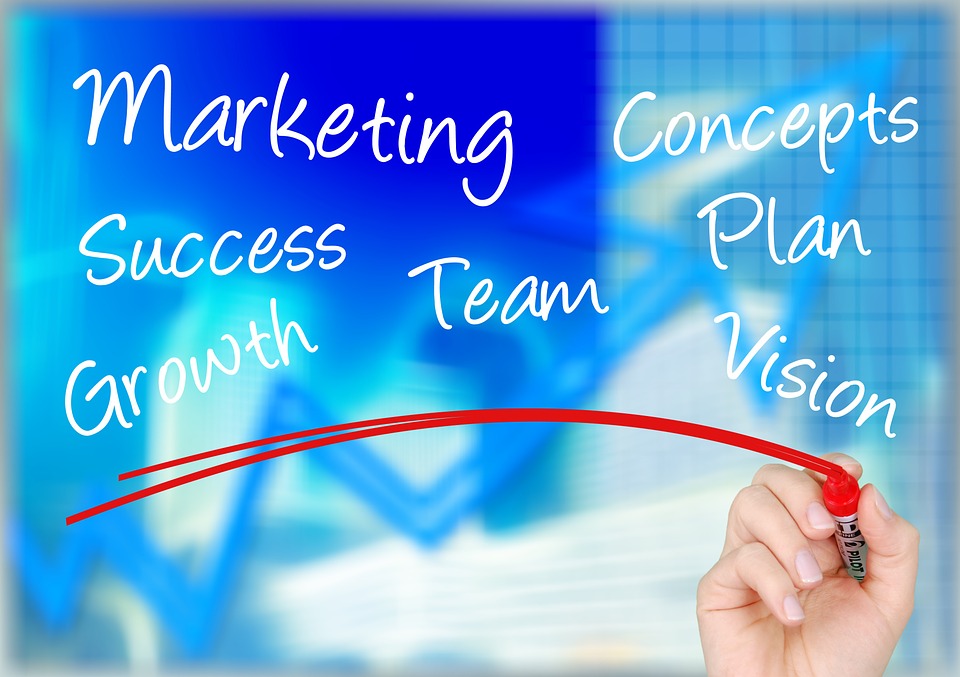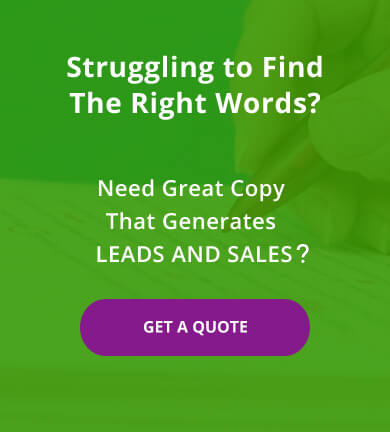Write Powerful Landing Pages that Convert Traffic into Sales
Turn Reads into Leads & Watch Your Business Grow
Need help writing a landing page? Get a no-obligation quote here.
Landing Pages Appear in Search Results
When the internet was in its infancy, companies built their websites with the home page as their online front door. They assumed most people coming to their site started on the home page and from there went to the pages most relevant to their needs.
But today, thanks to search engines that have continually improved their search capability, and searchers who’ve become more sophisticated in writing search queries, the home page of a website isn’t necessarily the one shown in search results. Instead, the page that is most relevant to the search request is the one presented.
While at first this created a conundrum for website owners. They worried that their visitors would be confused, much like a reader starting in the middle of a book instead of page one, they soon found a way to capitalize on this phenomenon. They began to develop landing pages that were search engine optimized.

Landing pages that follow SEO best practices can attract highly targeted traffic to your site.
Create Custom Landing Pages for Each Audience Segment
Landing pages are an opportunity to present your message to a specific audience. For example, imagine that your company manufactures stainless steel rivets that sell to two main markets: the auto industry and the military. Those two markets are unique in how they use the rivets, so it makes sense to write two distinct landing pages, one for each.
Separate landing pages allow you to target specific markets, similar to the way that magazines do. In your copy you’ll be able to highlight the features and benefits that are most relevant to their particular industry. You can even customize your offer.

Much like magazines target specific subscribers, your landing page should focus on one specific niche.
Because of their single-focused message, landing pages are powerful tools in achieving online success. They work for both B2B and B2C companies. And, most importantly, they do a better of job of converting visitors into customers than traditional web pages. The top 10% of companies see 3-5 times better conversion rates from their landing pages.
How Many Landing Pages Is Too Much?
There’s no such thing as overdoing it in terms of how many different landing pages you promote. The more landing pages you have, the more opportunities you have to attract leads,” according to KlientBoost.
Businesses that build up a big arsenal of segment-specific landing pages, are much better able to convert visitors into leads. That’s because the landing pages are highly relevant to different parts of their audience.
You need more landing pages. Companies see a 55% increase in leads when increasing their number of landing pages from 10 to 15, according to a HubSpot survey. “That percentage spikes even more when a company has 40 or more landing pages on their website.”
Consider These Questions Before Writing Your Landing Page
If within three seconds, visitors to your site can’t glean what it’s about and how it’s relevant to their needs, they’ll click the back button. So before crafting your landing page, you should clarify what you want to achieve, whether you’re selling a product, service or membership. Ask yourself the following five questions:
- Who is your product or service for?
- What is most important to them?
- What is the problem they’re trying to solve? (i.e. their pain point)
- What do you want them to do after reading your landing page?
- What promises can you make to cause that action?
With answers in hand, you should be able to write focused copy that achieves your objectives.
What to Include in a Landing Page
- Put the Visitor First — Everything about your landing page should align with your audience. The copy, graphics, fonts and even colors should all combine to create an image in your visitor’s mind. You only have 8 seconds on a landing page to make an impression.
- Craft a Compelling Headline — Write a headline with a sharp focus that speaks to your target market. Don’t worry about being clever. Clarity is more important than creativity. Your headline should tell your story in brief. It should be a concise statement that speaks toward solving the problem your visitors have. A good headline should seize their attention and entice them to keep reading.
- State the Benefits — Write out your biggest benefits and strongest objections. Then compose subheads to address each one. Arrange them in a coherent order to create an outline for your landing page.
- Add Facts — Flesh out the paragraphs. Strengthen your claims by providing specifics in the form of scientific proof, statistics and results. You want every statement to sound believable, not like hype. Less fluff and more facts will solidify your position.
Giving the facts was exactly what The Miller Firm, a Virginia law practice, wanted to do on its landing page seeking to attract defendants for a class-action lawsuit against a large pharmaceutical company. The case was complicated and other competing law firms glossed over the details on their web pages.
The Miller attorneys believed that what prospective clients wanted most was an understanding of what the case involved, why it had merit and how they could benefit by becoming involved. All of that information made for a lengthy landing page, but the law firm found the strategy was effective in differentiating them from competing law firms as well as converting visitors into solid leads.
Short vs. Long Copy
You may think people are too busy to take time to read lengthy copy. But that’s not necessarily the case, as was mentioned above in The Miller Firm’s landing page.
Shorter copy is okay for something not requiring a payment, such as a sign-up for a subscription, a free report or a request for more information.

Landing pages can have long, detailed write-ups provided they contain interesting, useful information that’s likely relevant to your target prospect.
Studies show longer copy works better for something that’s complicated to explain or requires payment. Even non-readers will read your entire landing page when they’re serious about making a purchase. Long landing pages have proven to result in more leads, according to Marketing Experiments.
So tell your story completely, and give prospects as much information as they need to justify reaching for their wallet.
Put Yourself in Your Visitors’ Shoes
A common marketing mistake is to make assumptions about your visitors’ knowledge. Often, visitors don’t know as much as you think they do. A better approach is to anticipate their questions and provide answers on your landing page.
Use bullets or numbered lists to break up big blocks of text. Put your most important points near the beginning of paragraphs and in subheads. That way even skimmers and skippers will get the gist of your copy.
Write in the second person, as in “you” and “your,” and not “I,” “we” and “we’re.” Using these pronouns will keep visitors engaged and forge a connection with them. It will also help them visualize how they, as opposed to an abstract person, can use your product or service and how it will have a positive impact on their lives.
Remember, visitors aren’t interested in your company. They just want to know if you’re offering the best solution to their problem.
A Sense of Humor Can Be Effective
Your landing pages don’t have to sound like formal speeches or English term papers. “I want to read boring copy,” said no visitor ever!

To keep visitors reading, feel free to insert some humor in your landing page copy if the topic is on the lighter side.
Go ahead and have a little fun, if the subject matter lends itself to a lighthearted touch. Inject some personality into your words. Be interesting and you’ll greatly enhance your visitor’s experience.
Don’t Forget Visuals on Your Landing Page
Besides making your landing page more visually appealing, images are persuasive selling tools. Visuals will help your readers consume your written information.
Choose photos, and videos if possible, that relate to the industry you’re targeting. Using videos on landing pages can improve conversions by 86%.
Show your product/service being used in context. Even better if your photo is out of the ordinary and therefore more interesting.

For landing page visuals, incorporate photos. Bonus points if they’re not only relevant but eye-catching.
Generic stock photos won’t be as effective as actual photos of your product and its application. And video has been known to improve conversions as much as 80%.
Your visuals should tell the same story as your words. In fact, every element of your page should be aligned conceptually with the subject and goal of the page. People in your target market should be able to instantly recognize the relevance to their needs.
Your Landing Page Must Build Trust
If a visitor has found your website via a search engine or some other referral mechanism, they likely don’t know anything about you yet. One of the primary objectives of a landing page is to inspire trust.
In addition to having a focused page that positions you as a specialist, you’ll want to also use other methods of social proof to confirm authenticity.
If you have any testimonials, whether in written form or video, place them on the landing page. Tell anecdotes of satisfied customers. You can even include links to any full-length reviews. Nearly 9 in 10 consumers trust reviews and testimonials.
These testimonials and case studies can be some of the most persuasive elements in your promotion, providing evidence your product or service lives up to your claims.
Additionally, use any seals or logos that provide credibility such as a Good Housekeeping seal, a Chamber of Commerce membership, a perfect rating from the Better Business Bureau or security verification from VeriSign. All these symbols prove the legitimacy of your business and help visitors feel more comfortable in doing business with you.
Contact Information Helps, Too
Include your contact information – at least a phone number and email address – on your landing page so people know you are real and can interact with you on a personal level if they desire. Also, by including both, you’re giving visitors the choice of how they prefer to contact you, which makes their follow-through more likely.
You may even consider including a physical address to further inspire trust, especially if your location could be seen as a selling point (i.e. many people prefer to do business with local companies).
Landing Pages Need a Clear Call to Action
A critical part of every landing page is the call to action. It should include strong, definitive instructions for visitors regarding what to do next. Should they call you? Should they click to another page? Should they subscribe?
Choose one. Multiple offers confuse visitors. In fact, they can decrease conversions by up to 266%! Instead of creating one landing page with multiple offers, a better approach would be to create several focused landing pages that you can market to different customer segments.
Use words that motivate readers to act such as: “free,” “new,” “buy” and “download now.” In fact, make the words into a big button, oversized is okay. Use a bright color like yellow so readers can’t miss it.
Place the button “above the fold,” which means the visitor should be able to see it without having to scroll down. If your page is long, repeat the call-to-action and button at the bottom or even multiple times to provide readers with an easy means to act, regardless of where they are on the page.
Consider using interesting visual cues to direct attention to your call to action, such as arrows or photos of people pointing toward the button.

Work with a landing page web designer to create visuals that attract the eye.
If you’re asking visitors to make a purchase, be sure you include a guarantee to remove risk and overcome any hesitancy they may have.
With a landing page, you don’t want visitors leaving that page until they have decided to make that purchase, sign up, download a white paper – or whatever else you want them to do. Providing clear and obvious directions on how they should proceed will increase your conversions.
Simplicity Is Key for Landing Pages
Even though landing pages can be lengthy, they shouldn’t be cluttered. Simple is good. Keep your statements concise and direct. Use conversational English for easy reading and to build a bond with your readers. Avoid jargon and literary flair that could detract from the meaning of your sentences.
Once you’re done writing the copy for your landing page, read it over carefully. Edit for brevity and readability. Delete any words and sentences that aren’t necessary to clearly convey meaning.
Don’t offer too many buttons or links. One call to action, possibly repeated a few times on the page, is usually all that’s necessary.
Too many options on a single page can be distracting and reduce response rates. Keep your landing page clean and focused.
One thing to keep in mind with regard to layout is how people read. They often scan a page rather than read every single word.
According to the Online Zero to Hero blog, “Eye-tracking research (where web readers’ eye patterns are measured) shows that readers often scan in an F-shaped pattern. That means they start at the top left corner and move to the right. They then move back to the left, but this time read a little less when they move to the right, and a little less in the next line, etc. The reading pattern then roughly ends up looking like the letter F.”
So, when designing your page be sure you prioritize your most important information for the top of the page, and especially the top corners.

Your landing page should be mobile-friendly and responsive so that it adjusts to whatever device your visitor is using.
Take the time to view your landing page on different devices. The design needs to be mobile-friendly. What looks great on a desktop PC might appear cut off or be too small to read on a Smartphone.
Finally, your landing page needs to load quickly. If you want to drop the bounce rate (people leaving your site immediately), you have to invest time in mobile landing page optimization because it will significantly improve the user experience for a lot of people, according to Truelist.
Page loading time is obviously an important part of any website’s user experience. A one-second delay in load time can decrease conversions by 7%.
“Google and other search engines penalize sites that load slowly—but more importantly, so do users,” according to SEO expert, Neil Patel. “They stop visiting, bounce, and don’t buy. You’ll lose out on sales and traffic if your landing page loads slowly.”
Test What’s Best for Your Landing Pages
Landing pages should be fine tuned over time. Use A/B testing to compare different elements of your page including:
- Headlines
- Body copy
- Photos
- Graphics
- Colors
- Layout
- Call to action
There’s no reason to guess what works when you can easily obtain hard data. Continue to test and tweak refining the copy.
Change one variable at a time and track conversions to determine what is effective. See what resonates most with your visitors. By identifying what copy modifications help increase your conversion rate, you’ll maximize your landing page’s success.

Consider creating multiple versions of your landing page. A/B testing will help you determine which version is most effective.
Proofread Your Landing Pages
Attention to detail is critical on landing pages. Typos, grammatical errors and inconsistencies will make visitors question your professionalism. They’ll also distract from your message.
Equally important is that your pages read well. Fix language that’s awkward and sentences that roll on for too long. Stick to one key thought per paragraph. Use language that will make readers feel like you’re talking to them.
There’s no substitute for good writing. If you want to inspire confidence in your business, you need to look like a capable, qualified company. Perfecting the content on your landing page will go a long way toward that goal.
Drive Traffic to Your Landing Pages
One of the most cost effective ways to attract traffic is through search engine optimization. Write your copy using keywords searchers use. Sprinkle those keywords in your heading, subheads and title tags. Most important, include good information that will be helpful to your visitors, and Google will reward you with a high ranking.
You can also use pay-per-click ads like Google Adwords, a banner or text ad, or even email marketing to attract traffic to your landing pages. Write your ad to specifically target your audience. Be sure the primary headline of your landing page matches the ad visitors click to get there. Track results to determine which channel performs best.

Use multiple marketing methods to drive traffic to your landing page. Track results to focus resources on those that work best.
Content marketing can also be an excellent way to attract visitors to your site. Post educational articles on your site that inform rather than sell.
You can also write guest posts for blogs that are relevant to your industry. Post press releases online as well, including a link to your landing page. And don’t forget about social media. Twitter and Facebook are great places to promote your content.
Individually, each of these methods may not result in a huge flow of traffic, but cumulatively, they can produce significant results. You’ll be building an audience that builds your business.
Copy for Landing Pages, Your Primary Goal
You only have a few seconds to grab visitors’ attention. They are anxious to move on, ready to make a snap decision if you’re not offering what they need.
Your goal, in writing and designing your landing page, is to make it readily apparent how your product or service will benefit them. If you can do that, you’ll convert reads into leads, and watch your business soar!
Need help writing a landing page? Get a no-obligation quote here.
Landing Page Infographic
Check out this infographic for a quick summary of all the points covered above.

Ready to get started on your landing page? The sooner you publish, the sooner you’ll start generating inquiries. After that, it’s just a short funnel ride to closing more sales!
* * *
Contact Susan Greene
Do you need help writing a landing page that generates leads for your business?
Get a quoteTestimonial
Looks amazing
We love everything about this website copy! Looks amazing. Thank you again for all your help in launching Ledger Lovers Co. bookkeeping services.
Anna Hoopes Mandac
Owner
Ledger Lovers Co.
Cleveland, Ohio


